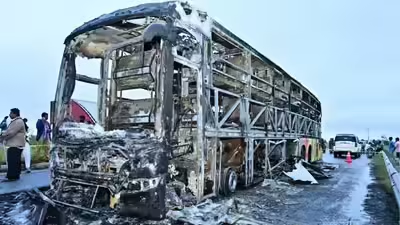
DELHI: A fresh discovery has surfaced during the ongoing inquiry into the Kurnool bus fire case.
When the disaster happened, the bus that exploded had a shipment of 400 iPhones.
According to forensic specialists, these phones’ detonating batteries may have increased the fire’s ferocity when it enveloped the bus, killing at least 20 passengers.
The package was on its way to Bengaluru, where it would be delivered to customers by a major online retailer.
To ascertain the precise origin of the fire, chemical analytical experts have gathered samples as part of the continuing inquiry.
Officials said preliminary assessments indicate that the fire was started by the bike’s gasoline tank exploding, but the presence of a shipment of around 400 cell phones with lithium-ion batteries may have made the fire worse.
Serious safety flaws in private long-distance bus operations were revealed by the Hyderabad-Bengaluru Kaveri Travels bus fire.
The whole car was consumed in 10 to 15 minutes after the fire, which started close to Kurnool, spread so quickly that the occupants had little opportunity to flee.
Such events, according to auto experts, are not unique and are often connected to malfunctioning emergency exits and unauthorized electrical modifications made to buses in order to improve comfort or luxuries. They clarified that the original electrical system of the car is often overloaded by these changes.
Fire authorities in Telangana emphasized the need of routinely maintaining air conditioning systems, which operate at high pressure and may exacerbate overheating if not maintained.
Experts are calling on the government to enforce safety regulations more strictly, require private bus operators to have their electrical systems inspected, and punish illegal workshops as the Kurnool catastrophe probe proceeds.
A senior fire department official said, “The combination of carelessness, unlawful modifications, and lax regulation will continue to put lives at risk on our highways unless urgent corrective steps are taken.”